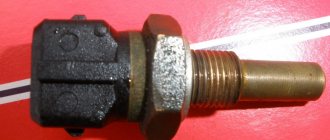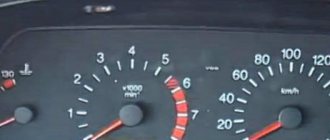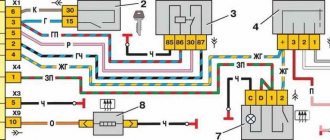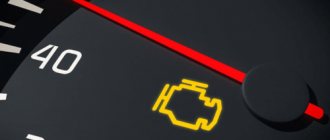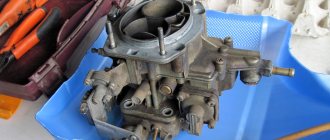The most common reasons: what is the problem?
It is worth noting that a malfunction can be determined by indirect signs without even opening the hood of the car.
For example, if the starter turns, but the engine does not catch on or immediately stalls, the problem lies in the fuel system. Without exception, all the reasons for the impossibility of starting the engine can be divided conditionally into two main groups: It is also necessary to include the following in a separate category of faults: the engine “knocked”, the timing belt broke. In this case, expensive repairs will be required. In other cases, you can get by with a little bloodshed.
Why is it dangerous to turn the starter for a long time when starting the engine?
Starting an engine is a process in which the starter and battery are directly involved. They are the ones who suffer the most when starting the engine for a long time. Accordingly, the following problems are possible:
- Low battery. Each time you try to start the engine, battery power is consumed. Moreover, if the attempt is not successful, then we can assume that the battery is consuming its charge “idle”. In order for the battery to charge, the engine must start and run for a while. Several unsuccessful attempts to start the engine, and you will get a discharged battery, which will need to be charged from the station, or you can start the engine “by lighting” in other cars;
- Starter failure.
When the starter is cranked for a long time, it begins to overheat, which can negatively affect its components and lead to complete failure of the part. Also, do not forget about the bendix, which when trying to start the engine is connected to the crankshaft. If the engine does not start, there is a high risk of damage to the splines on the bendix or the bearing. If you constantly have to turn the starter for a long time when starting the engine, over time this will lead to its failure and the need for replacement. Most often, you can solve the problem with the starter cranking for a long time when starting the engine without contacting a service center yourself, thereby preventing early failure of the starter.
The main problems associated with the operation of the fuel system
Engine starting is primarily affected by the following main components of the fuel system:
- gasoline level in the tank;
- the condition of the fuel line under the bottom of the car;
- cleanliness of filters.
It should be noted: even if there is gasoline in the tank, the car may not start. And the reason for this is the low fuel level. The pump may simply not be drawing in enough gasoline. Therefore, before starting to diagnose and inspect all the main components, it is advisable to fill the tank to at least a third. If problems with the electrical part are excluded, you need to pay attention to the fuel line. You need to check:
- no breakdowns or leaks in the fuel supply pipe under the bottom;
- the condition of the fine filter - often it simply becomes clogged, which leads to a decrease in the pressure level in the fuel system.
It is not possible to check the operation of the fuel pump manually on this car. This can only be done by ear. If, when you turn the key and turn on the ignition, the pump makes noise, then it is “alive”. Otherwise, you need to check whether power is supplied to it. If this is all right, you need to replace the pump. Its cost ranges from 1.5 to 3 thousand rubles, depending on the manufacturer.
You can check the pressure level yourself - just connect a special pressure gauge to the fuel system in accordance with the manual. This will allow you to diagnose the problem. According to the standard, the pressure should be at least 2-2.5 atm. If the indicator is less, then the engine will not start.
Injector problems
Why doesn’t the car start when it’s hot if, for example, it has an injection engine? There are also a lot of problems with such cars, mainly due to sensors, but there are also other problems. There are several options here:
- Coolant sensor malfunction. Since the injection system is almost completely automated, its operation depends on the readings of sensors located in the gas tank, engine and other components. As soon as the reading device produces incorrect information, the entire system begins to malfunction. For example, problems in the readings of the coolant sensor lead to the fact that the ECU, which reads the device information, gives the wrong command to other operating elements. As a result, the wrong amount of fuel enters the chamber, which is why it is impossible to create a combustible mixture. The solution to the problem is to disconnect the sensor, clean it, or replace it if it is damaged.
- Problems with injectors. This is an extremely rare case of malfunction, but it does happen. The breakdown consists of a breakdown of the injector, and for this reason fuel is not supplied. The lack of pressure inside the channel leads to the fact that fuel does not enter the combustion chamber. The injectors need to be replaced.
- Faulty air flow sensor. As in the first case, it can easily fail, which disrupts the operation of the system for creating a combustible mixture. As a result, the fuel is either too rich in oxygen, or, conversely, poor. In both cases, fire does not occur, and therefore the engine does not start. The following symptoms accompany the problem: surges in engine power, strange sounds when starting the engine, the sound of a strong exhaust from the gas exhaust system, failures when pressing the gas. Replacing the device and adjusting the entire system should help.
The starter works, the engine turns, but the car does not start
So, the starter, like the engine, the pistons move, but the engine still won’t start. There is already a problem here, most likely in the fuel-air mixture, perhaps the marks have come off, etc.
Before you sin on this, the first thing you need to pay attention to is the crankshaft sensors:
DPKV - if it malfunctions, it is very difficult to start the engine, and once it is running, it runs unevenly, intermittently, and the power drops noticeably.
Next you should pay attention to the labels:
- Mark on the timing camshaft gear (photo).
- Markings on the flywheel under the thermostat (photo).
If the marks do not match, most likely the belt has simply slipped by one tooth. The camshaft gear itself may be worn. It needs to be adjusted and installed correctly!
Next we will talk about the air-fuel mixture.
I warn you in advance that the easiest way is to do computer diagnostics of the engine or look at the errors on the on-board computer.
The air-fuel mixture is the combination of air, gasoline, and the spark needed to ignite it.
Air supply
As a rule, a malfunction in the air supply should not affect the engine starting problem. At the very least, the engine should still run. Nevertheless, let's not bypass the air system.
The following sensors are responsible for air metering and supply:
- Mass air flow sensor is the most expensive sensor. If it fails, then the car simply begins to consume liters of gasoline, then this sensor can simply die “to zero”, but it indirectly affects the starting of the car. This means, no matter how it fails, the car should start.
- The IAC should not affect the engine starting problem. If it malfunctions, problems arise from idle.
Spark
Here may be the real reasons for our problem:
- First of all, we look at the candles. We turn them inside out (How to remove candles?) and look at their condition. Normal ones should have a slightly brick color, if they are wet, the candles will flood accordingly. It is necessary to clean and bleed the cylinders by idling the engine with the starter with the spark plugs turned out. If one cylinder is flooded, the problem is local (high-voltage wires, faulty spark plug, injector), all cylinders are flooded - a general problem (ignition coil, brains, oxygen sensor, fuel pressure in the rail).
- Next, check for the presence of a spark. To check it, check out the following article: How to check the spark?
- If there is no spark on one cylinder, there is a faulty spark plug or high-voltage wire.
- If it is missing on two adjacent cylinders (1-4 or 2-3), then the problem is in the ignition coil or in the ECU.
- If there is no spark anywhere, the problem may lie in the ignition coil or ECU, in mismatched timing marks, or inoperative DPKV.
- If there are no problems with the presence of a spark, then the cause of the malfunction lies in the fuel supply.
Impact of sensors
Most VAZ-2115 cars operate on the “January 5.1” controller. Crankshaft, temperature and throttle sensors are involved in starting the engine.
DPKV malfunctions usually appear regardless of temperature, but it is worth checking its resistance and comparing it with the data in the calibration table.
A more common malfunction is DT . Remove from position and place in a container with a cooler. We measure the resistance with a multimeter: it should be in the region of 1350 - 1880 Ohms. If you have a thermometer, you can check it using the table. If not, it doesn’t matter either, just heat it to an arbitrary temperature. As T increases, the resistance decreases. On a fully warmed up engine it is 87 - 109 Ohms. If the ohms do not change or drop to 0, change the DT.
The throttle assembly is completely disassembled and cleaned. One of the problems is dirt, which expands when heated and interferes with the normal operation of the injection. If the TPS , the car not only does not start when hot, but also “does not drive” (sometimes stalls and does not start) after warming up.
The TPS is checked with an ohmmeter with the engine running. Place the multimeter on the input and output contacts, ask an assistant to press the gas. The readings should change and return to their original values at XX. If the resistance does not change when you press the pedal or the device shows infinity, the sensor needs to be replaced. At the same time we check the IAC. It usually causes the car to be unstable at idle or stall but start.
A malfunction of the mass air flow sensor on cars with January 5.1 is recognized by the fact that the car starts when hot and immediately stalls. The sensor comes into operation only after startup. But on a car with January 7.2, the mass air flow sensor is involved in the start - without it the car will not start.
Problems associated with the electronic ignition system
It sometimes happens that the engine does not start well when it is cold or frosty. The reason may lie in a faulty battery or simply in its discharge. You can check its status in the following ways:
- using a multimeter - the normal voltage between the terminals should be 12.6 V;
- using a hydrometer - normal density differs depending on the ambient temperature.
For example, if the engine does not start well at low temperatures even when it is hot, then the reason, obviously, lies precisely in the low battery charge level. Main electrical problems:
- the ignition switch is faulty;
- one of the two relays installed under the hood - ignition and starter - is damaged;
- the starter does not work;
- retractor device.
The ignition switch is one of the weak points of almost any car. Moreover, the VAZ 2114 is no exception. Checking its operation is quite simple. All you need to do is dismantle the device and then test all contacts using a multimeter. If it fails, the easiest way is to replace the ignition switch. There is no point in repairing it.
It is not possible to check the ignition and starter relays without opening them. Therefore, the best solution would be to simply replace both of them at once. Their cost in the store usually does not exceed 250 rubles per piece.
You can determine the functionality of the relay simply by sound. If after turning the key it clicks, it means that voltage is coming to it, it is being applied, it works as it should. When the ignition switch is working properly, the relay clicks - the next unit to check is the starter. Usually the problem lies in the retractor.
Sometimes just a light blow with a key helps solve the problem. If you have a heated, well-lit garage, the starter should be removed and carefully inspected. Brushes usually fail. If the car's mileage is significantly more than 150 thousand km, the bearing may fail. After removing the starter, you can try to start it directly from the battery. It's very easy to do this:
- the housing must be connected to the zero terminal;
- The positive terminal should be connected directly to the retractor using an alligator clip.
If the starter is working properly, it should turn over. If there is no reaction, the problem most likely lies in the retractor.
Malfunctions of the car ignition system and other breakdowns
The battery is discharged or faulty. The connection contacts have oxidized. As a result, the starter does not receive enough starting current to crank the engine.
- Spark plugs are flooded.
- One of the three sensors is faulty:
- DPRV (sensor responsible for the position of the camshaft);
- PDZ sensor (throttle position);
- MAF (mass fuel flow sensor).
- The ignition timing is incorrectly set.
- The timing belt or its drive is damaged.
- Problems with oil, there was no change from summer to winter.
- The fuses have blown.
- It breaks through the armored wire.
- And similar problems.
It would take a very long time to list the possible reasons why a practically new car, not to mention used VAZ models. In this case, the solution to the problems that arise is both independent repair within some 10-15 minutes (if you have the appropriate knowledge, experience and spare parts), and rather labor-intensive work. We are not able to provide advice on how to correct each of the cases we have named due to the limited space of our article. But we will still allow ourselves one – a common one.
Winter never comes unexpectedly (we don't mean utility services, for them winter is always news). Thus, in anticipation of the oncoming cold weather, carry out a preventive inspection and, if necessary, repair of your personal vehicle. Replace questionable parts (filters), change the oil, check the injector, and so on.
And then the question of why the VAZ-2115 (or any other make and model) starts poorly or does not start at all, even in mild frost, will be irrelevant for you.
Ignition problems
Most often, the reason lies precisely in one component of the ignition system. Weaknesses that are the first to come under suspicion are:
- egnition lock;
- induction coils;
- starter and ignition relay;
- lack of voltage at the battery terminals.
Most often, the problem lies in a banal lack of voltage at the ignition switch contacts. It is supplied directly from the battery to the starter.
If, after turning the key, the dashboard goes out or does not light up at all, it may be a problem with the cylinder.
Checking the functionality of the ignition switch is relatively simple:
- it is necessary to dismantle the larva;
- Using a multimeter, the contacts are called in different positions.
If there is no contact, then you should simply purchase a new lock. It simply doesn't make sense to repair it.
Problems of domestic cars
Many domestically produced cars also have trouble starting when the engine is hot. The problem is in the design, but this time the gas tank. The fuel pump, which heats up during operation, should, in theory, cool down a little during operation. This occurs due to the liquid that moves through its body. During the summer heat, the liquid heats up, so cooling does not occur, which leads to disastrous consequences.
A faulty high-pressure fuel pump (HPF) stops working, which leads to a disruption in the fuel supply to the engine. Subsequent turns of the key and pushes will not help, but there are several “old-fashioned” methods. The device needs to cool down.
- Wet a cloth in cold water and apply it to the fuel pump housing until it cools down.
- Roll the car to a cool, sheltered place from the sun, open the hood. Wait a while for the unit to cool down. This usually takes 15–20 minutes.
If the starter turns, but the car engine does not start
In this case, first of all you need to check whether there is a spark. You can do this as follows:
- all power wires with candlesticks must be disconnected;
- then one of the candles is unscrewed;
- neatly connects to the armored wire;
- Next, you need to place the spark plug housing on the cylinder block.
You should try to “turn” the starter - if after this a bright blue spark jumps between the central and side electrodes, then there are no problems. If there is no spark or is red, then the spark plug will need to be replaced. Even if out of 4 only one spark plug does not work well, the car will no longer start the first time.
Ignition module
Another problem is the ignition module. This malfunction was more common on cars of the Samara-1 generation. In the case of Samara-2, the quality of the part itself has improved, but the root of the problem remains. The module is attached to the cylinder block, which causes it to get very hot and burn out the windings. As a result, when hot, it is possible to lose spark in one, several or all cylinders at once.
If the car does not start when hot, check the spark. If it doesn't, that's almost certainly the problem. You can usually resolve the issue by replacing the module, but if the problem returns, consider moving the bracket to another location. Most often it is installed in the front part of the engine compartment, near the radiator.
Most problems with poor engine starting when hot are solved using these methods. But less probable ones are also possible: broken wiring, ECU malfunction, etc.
Source
Other faults
The injector makes it quite easy to determine the cause of the malfunction. But repairs are much more difficult than on cars equipped with a carburetor engine. VAZ 2114 is equipped with engines of various powers. Easier maintenance with 8 valves. If the car takes a long time to start and the exclamation mark is on, then the reason may lie in the following:
- incorrect operation of injectors;
- poor quality fuel;
- low pressure in the ramp.
Often, over a long period of use, the injectors simply become clogged. As a result, they require cleaning. It is difficult to cope with such a task on your own. The solution may be to contact a specialized service. Cleaning is usually performed using ultrasound. Another option is low quality fuel mixture. If the car begins to stall or loses power immediately after refueling, then the problem lies precisely in gasoline.
Lack of sufficient pressure in the ramp is another common reason. It can be measured using a special pressure gauge. Normal pressure is 2-2.5 atm. If it is lower, then the engine simply will not start. If you cannot independently determine the reason for the inability to start the engine, you should contact a service center.
The VAZ 2114 car is easy to repair and maintain. You just need to monitor the quality of the fuel being poured, and also change consumables in a timely manner.
Doesn't start well when hot
New VAZ 2115, the following glitch is observed: cold start without problems, I drive for half an hour, no failures, everything is ok, I turn off the engine, after 5 minutes I try to start it - it snorts and stalls, after 15 minutes of waiting it starts normally. I know that I need to go for diagnostics, but does anyone have any suggestions?
- There was the same glitch 21093i engine 2111 BOSCH controller. The problem turned out to be the Crankshaft Position Sensor. After the replacement, I drove almost 13,000 miles - the glitch did not appear. The issue price is 60 rubles per sensor. The diagnostics revealed DPKV only after the computer showed 600 rpm with the car not running. There were no other errors. Z.Y. If you have any questions, write to martrv dog meijin dot ru
- Try starting it like this: turn on the ignition and wait for the fuel pump to click. Turn off the ignition. You turn it on again, wait for the click and try to start it. (as an option - a vapor lock in the fuel rail).
- 90% of cars with such engines behave this way; this is the reason for this phenomenon, most likely in the RTD.
- This is the only correct answer. The RTD membrane is broken and gasoline is slowly flowing into the receiver. In 5 minutes it manages to relieve all residual pressure in the ramp. The engine starts like it's flooded. Gasoline consumption is correspondingly increased slightly.
- if the engine engineer then the injectors are leaking. after turning off the ignition, they bleed pressure into the intake manifold - the mixture becomes over-rich, I have the same bullshit. turn with the slipper pressed to the floor.
- try turning on the throttle during start-up, if it starts and doesn't hold idle, then it's the idle speed regulator.
VAZ 2115 injector 8 valves does not start when hot - reasons
WILL NOT START AND STALL WHEN STARTING A HOT VAZ 2115
On a VAZ 2115, it starts perfectly when cold, but when starting hot, it immediately stalls. After it cools down, it starts without problems. What could be the reason?
Poor hot starting is one of the diseases of VAZ cars. Therefore, the question is very common. This happens due to the low quality of spare parts and some design features. It happens that the fuel pump is replaced with a new one, but it turns out to be faulty. “In search of a malfunction” everything is changed, and the problem is revealed already on the second round.
If the car does not start when hot, we recommend checking using the following algorithm:
- Point for beginners. Make sure that the problem is related to the “hot” state of the car. Check the battery charge, make sure that the generator is charging (with a multimeter in voltmeter mode). Are there any problems with the starter? If it sometimes turns, sometimes it doesn’t, or occasionally turns poorly, take it to an electrician.
- For everyone else. It is advisable to start repairs with diagnostics - it can help save money. A diagnostician will reveal approximately 80% of the causes of the problem, the faulty part will be replaced, and the car will drive and make you happy.
Finding the reasons for a poor hot start
Dear friends. For a long, long time since I bought the car, I have been plagued by the same problem - poor starting of the engine when hot after 10-20 minutes of inactivity. Cold starts are just perfect. When it’s hot, you have to press the gas pedal to get it, it can turn for up to a minute, but then it grabs.
The injectors were cleaned, the two-pin DOT sensor was changed, the fuel pressure sensor was replaced, the spark plugs + armored wires were replaced, and a new fuel pump. But the reason never went away.
The last thing I did was replace the brains, from 2111-14110-20 to 2111-14110-20-70. The DD has been changed to a new Euro model. But the problem doesn't go away.
Tell me where to dig next?
Possible reasons why an injection engine does not start
Fuel system
It is necessary to diagnose the fuel supply system. In domestic fuel-injected cars, when the engine starts, you can hear a specific buzzing sound from the rear of the car. This sound indicates that the fuel pump is operating. Accordingly, if such a buzzing noise is not observed, most likely the problem lies in the pump.
You need to check the fuses that control the fuel pump, the main engine control relay and the fuel pump relay. In some cars of the VAZ family, fuses are hidden under the glove compartment, in others behind the heating panel cover on the passenger side. If the fuses are ok, check the relay.
You can touch it, and a specific click should sound. If the relay is also working properly, you need to check the pressure in the fuel system. The best way to do this is with a pressure gauge. If this is not possible, you will have to find a spool, which should be under a protective cap.
When you press it, you should feel pressure. Some models do not have a spool. Then you need to disconnect the fuel supply pipe. If the pump is working, then pressure should also be felt under your finger.
Possible causes may also be clogged fuel filters or fuel supply pipes. There may also be such a banal reason as lack of fuel in the tank.
If it turns out that all elements of the fuel system are in order, then the next thing you should pay attention to is the ignition system.
Ignition system
The main thing you need to be sure of is the presence of a good spark, that is, a discharge between the two contacts of the spark plug. If the starter turns, but the engine does not start, then there is a high probability of a malfunction in the ignition system. This is where we need our spark gap. If you check the spark plug without it, for example, by attaching it to the engine, then the resistance will be too high.
Therefore, we will not be able to accurately check our spark plugs and, in addition, the controller may be damaged. After checking the fuel system and ignition system and not finding the cause of the malfunction, you will need to check the engine. Most likely, this is the reason.
Starter malfunction
This can be a very common reason why the car engine does not start. In order to establish the possible cause of a starter failure, it is very good if the car enthusiast has at least an approximate understanding of the structure of this mechanism and how to check whether it is working.
It is important for owners of foreign cars to know that imported starters can stop turning even due to lack of lubrication or when dirty. In this case, the solution is very simple: remove the starter from the engine, thoroughly clean it from dirt and thoroughly lubricate the necessary mechanical components. Moreover, the used lubricant must be removed. In principle, this is not difficult, but if it doesn’t work out, then it’s better to contact a specialist.
Some starter malfunctions can be determined by ear. If you turn the key in the ignition switch, the starter makes a click, but it does not start, then most likely the relay is faulty. If possible, then you need to repair it. If the relay cannot be repaired, then it is worth replacing it. Only dismountable types of relays can be repaired.
Accumulator battery
The battery must be undamaged and the terminals clean and free of oxide, otherwise there will be no good contact between the battery and the vehicle's electrical wiring. The battery must have sufficient charge and “hold” it.
Diagnostics
So, to determine the specific reason for the long start-up of an injection-injected internal combustion engine, you should start with a high-quality diagnosis. Usually, they check the compression in the cylinders. Its values must be within 12 atm for this to be considered normal. In this case, there should be no deviations between these indicators in each of the cylinders (maximum - 1 atm).
Then the spark plugs must be replaced. This will have an effect on the engine and it will now start much faster. However, if everything is not in order with the motor, then the normal starting time will last only 1-2 days.
Therefore, high-voltage wires should also be diagnosed. Diagnostics will make it possible to find out whether the cables have a breakdown, which is clearly visible by the spark coming out at night. This is done as follows: the car starts in the dark, at the same time you need to monitor which wire sparks.
The ignition coil also needs to be checked. Many experienced drivers do this: they install a known good and new module instead of the original one, then check the engine starting for several days. If everything is normal, the start-up does not take long - it means that the whole problem was in the bobbin (ignition coil).
If there are no changes, the test continues. This time you should test all filters, including the air filter. Next is checking and replacing all sensors and regulators. Pay special attention to the mass air flow sensor.
The next stage: testing various connections, checking the wiring for good contact, cleaning the masses and flushing the throttle assembly.
If nothing changes again, then it is recommended to check the engine fan relay. It often causes similar problems with starting on a fuel-injected internal combustion engine. You can test the relay if you remove the wire from the temperature controller installed on the thermostat.
The fan should turn on after these steps. However, after measuring the resistance value on a warm internal combustion engine, the system can produce low temperature data, although the temperature inside the engine is clearly more than 90 degrees. Why is there such a difference? It turns out that this may well be a buggy DTOZH, which for some reason was not checked earlier. It must show the real coolant temperature, otherwise chaos will begin in the system, and it is not surprising that the engine takes so long to start.
